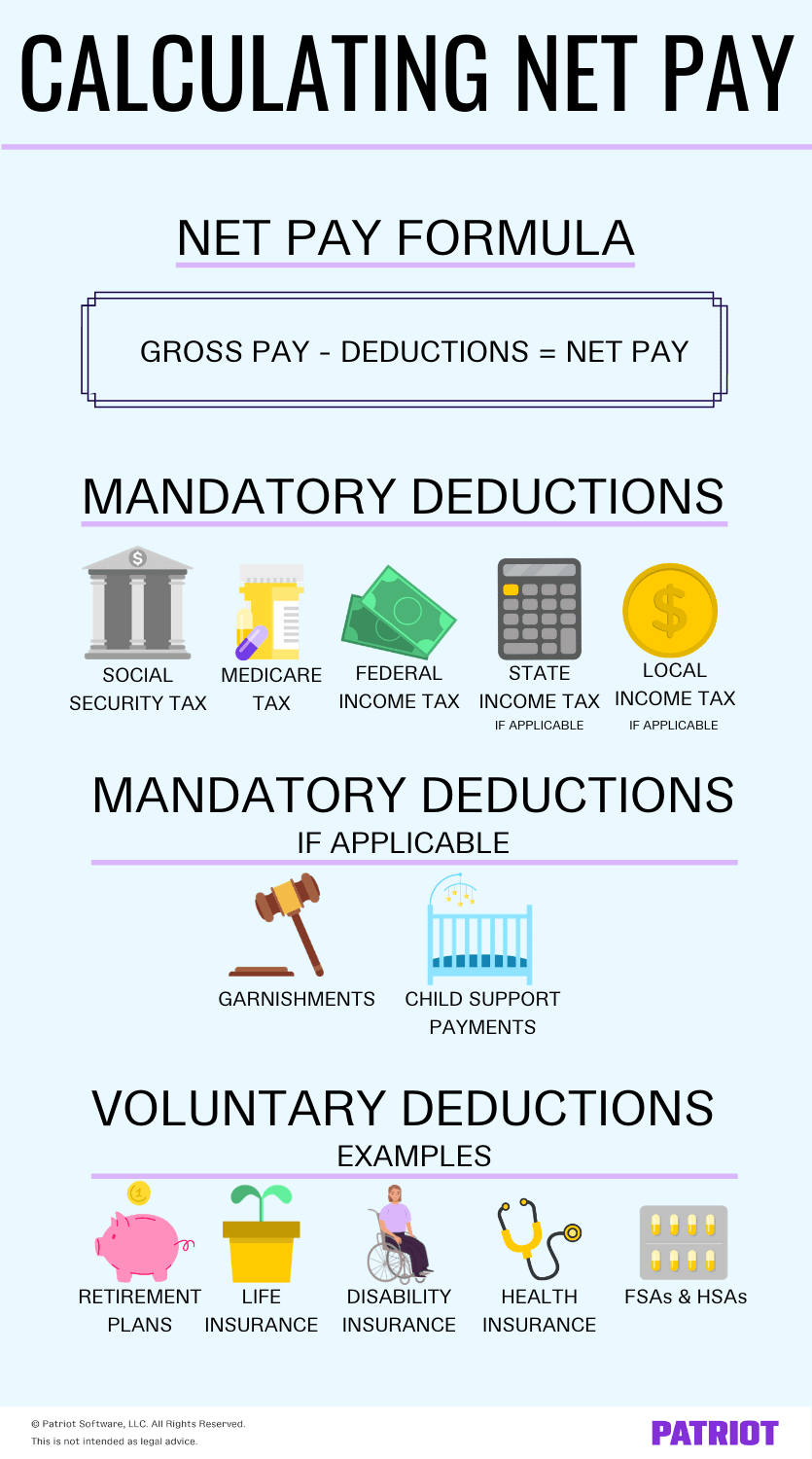Employee salary: $50,000 a year. But you know that’s not what they’re walking away with. Between taxes and benefit deductions, the employee’s take-home pay could be far from the $50,000 sticker price (cue the sad violin). Learn how to calculate net pay to find your employees’ take-home wages.
After all, you want to run an accurate and legal payroll to avoid penalties and fees, and part of that requires you to know the gross-to-net calculation.
Skip Ahead
What is net pay?
Net pay is the take-home pay an employee receives after you withhold payroll deductions. You can find net pay by subtracting deductions from gross pay.
Here’s how it works. An employee starts out with their gross pay. But after taxes and other deductions, they walk away with their net pay. Take a look at the breakdown below.
What is gross pay?
Gross pay is an employee’s income before taking out deductions. Unless you gross-up an employee’s wages, gross pay is usually the “sticker price” you offer.
What are deductions?
To calculate net from gross, you must withhold deductions each pay period. There are both tax and non-tax deductions. And, some deductions are mandatory while others are voluntary.
Taxes are mandatory. You may need to withhold the following from an employee’s gross pay:
- Federal income tax
- Social Security tax
- Medicare tax
- State income tax, if applicable
- Local income tax, if applicable
- Other state-specific taxes
Some non-tax deductions are mandatory, too. If you need to withhold these types of deductions, the appropriate agency notifies you. Examples include:
- Garnishments
- Child support payments
Voluntary deductions (i.e., benefits) include:
- Health insurance premiums
- Life insurance premiums
- Retirement plan contributions
- Flexible spending account (FSA) contributions
- Health savings account (HSA) contributions
How to calculate net pay
So, how is net pay calculated? Think of calculating net pay like a simple math problem. And like all math problems, there’s a net pay formula you need to know about:
Net Pay = Gross Pay – Deductions
To calculate net pay for your employees, you need to be able to answer three questions:
- What are the employee’s gross wages for the pay period?
- How much are taxes?
- How much are non-tax deductions?

1. What are the employee’s gross wages for the pay period?
How you find an employee’s gross wages for the pay period may depend on whether they are salaried or hourly.
Generally, a salaried employee earns the same amount in gross wages each pay period (unless they’re eligible for overtime pay). An hourly employee’s gross pay depends on the number of hours they work during the pay period.
Want to find a salaried employee’s gross pay each pay frequency? Divide their annual salary by their pay frequency:
- Weekly: 52
- Biweekly: 26
- Semi-monthly: 24
- Monthly: 12
Want to find an hourly employee’s gross pay each pay frequency? Multiply the employee’s hourly pay by the number of hours worked during the pay period.
2. How much are taxes?
Determining tax withholding requires some extra calculations and work. Some taxes are flat rates while others use tax tables.
Social Security and Medicare taxes make up FICA tax. The FICA tax rate is a flat percentage of 7.65% that you hold from each employee’s wages. Of this 7.65%, 6.2% goes toward Social Security tax and 1.45% goes toward Medicare tax. Keep in mind that there is a Social Security wage base and additional Medicare tax, if applicable.
Federal income tax withholding varies. The amount you withhold depends on the employee’s:
- Pay
- Form W-4 information
- Filing status (e.g., Single)
Use each employee’s W-4 form and the federal income tax withholding tables in IRS Publication 15 to figure out how much the employee owes in federal income taxes.
State and local income taxes vary by state and locality. Check with your state for more information.
3. How much are non-tax deductions?
You also need to determine whether to hold additional money for employee benefits and other non-tax deductions. Keep in mind that some of these deductions are pre-tax while others are post-tax.
If an employee has a pre-tax deduction, subtract the amount from their wages before you figure out some or all of their taxes. This lowers their taxable income. Examples of pre-tax deductions include health insurance premiums, some retirement plans, and life insurance premiums.
If an employee has a post-tax deduction, withhold the amount after you’ve figured out their taxable income. Examples of post-tax deductions include Roth retirement plans and wage garnishments.
Calculating net pay example
Want to see how to calculate net pay from gross pay in action? Let’s say your employee, Pam, is a single-filer living in Ann Arbor, Michigan.
Pam makes $20 per hour and works 40 hours per week. You pay her weekly, so her total gross is $800 ($20 X 40 hours). She does not work overtime.
Pam has health insurance. Her wages are subject to federal income, FICA, and state income tax. Ann Arbor does not have local income tax.
To go from gross to net, first calculate her deductions. Then, subtract the deductions from her gross wages.
1. Calculate the deductions
First up: calculate Pam’s tax and non-tax deductions. Because her health insurance premium is a pre-tax deduction, withhold it before calculating taxes.
Health insurance premium
Pam’s health insurance premium is $50 per week. Health benefits are exempt from Social Security, Medicare, and income tax withholding.
Subtract the $50 from Pam’s gross wages first:
$800 – $50 = $750
Pam has $750 in taxable gross wages.
FICA tax
To determine how much of Pam’s paycheck goes toward FICA tax, multiply her wages after the pre-tax health deduction ($750) by 7.65%.
$750 X 0.0765 = $57.38
Withhold $57.38 in FICA tax from Pam’s gross pay.
Federal income tax
Pam has a 2024 Form W-4 on file and uses the standard withholding. So to find federal income tax withholding, use the wage bracket method tables for manual payroll systems with Forms W-4 from 2020 or later in Publication 15-T.
Pam’s $750 taxable wages fall between $745 – $755. Using the wage bracket method tables, you find that her federal withholding is $51 each week.
State income tax
Michigan has a flat state income tax rate of 4.25%. Multiply $750 by 4.25%:
$750 X 0.0425 = $31.88
Withhold $31.88 from Pam’s gross wages for state income taxes.
Local income tax
Ann Arbor does not have local income taxes. Do not deduct anything from Pam’s gross pay for local income taxes.
2. Subtract deductions to find net pay
To calculate net pay, deduct FICA tax; federal, state, and local income taxes; and health insurance from the employee’s gross pay.
Using the formula to calculate net pay, determine the employee’s net pay.
Net Pay = Gross Pay – Deductions
Here’s a rundown of the withholding amounts we calculated:
- Gross Pay = $800
- Health Insurance Premium = $50
- FICA Tax = $57.38
- Federal Income Tax = $51
- State Income Tax = $31.88
- Local Income Tax = $0
Net Pay = $800 – $50 – $57.38 – $51 – $31.88
Net Pay = $609.74
This article has been updated from its original publication date of 10/19/2016.
This is not intended as legal advice; for more information, please click here.



